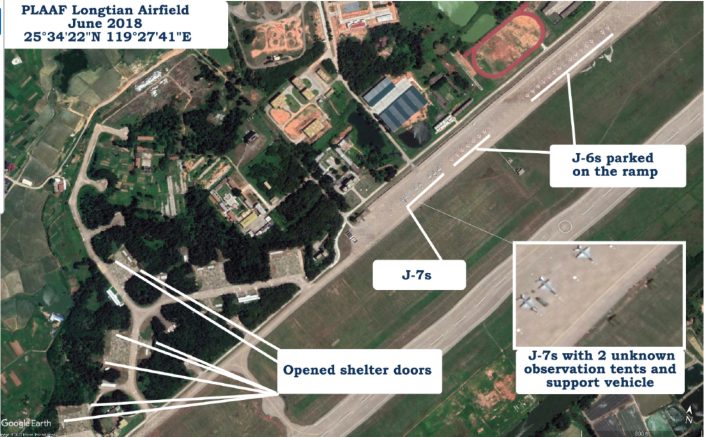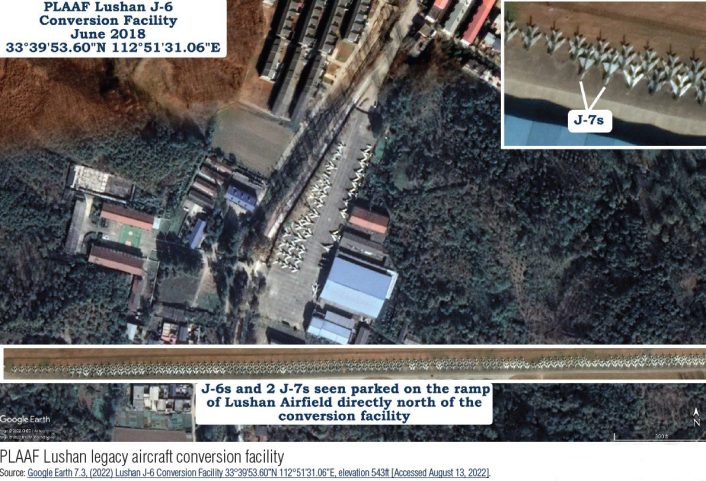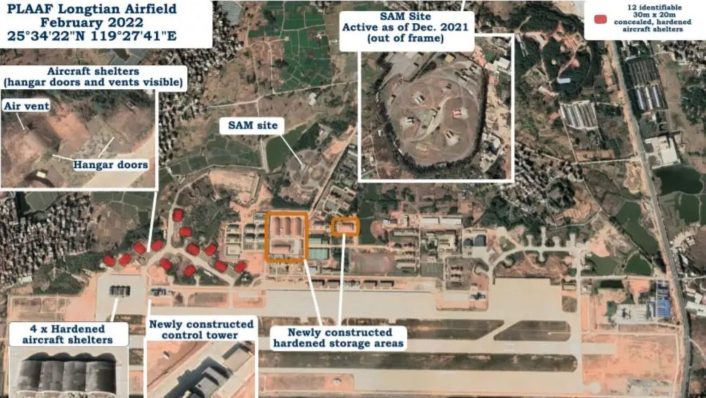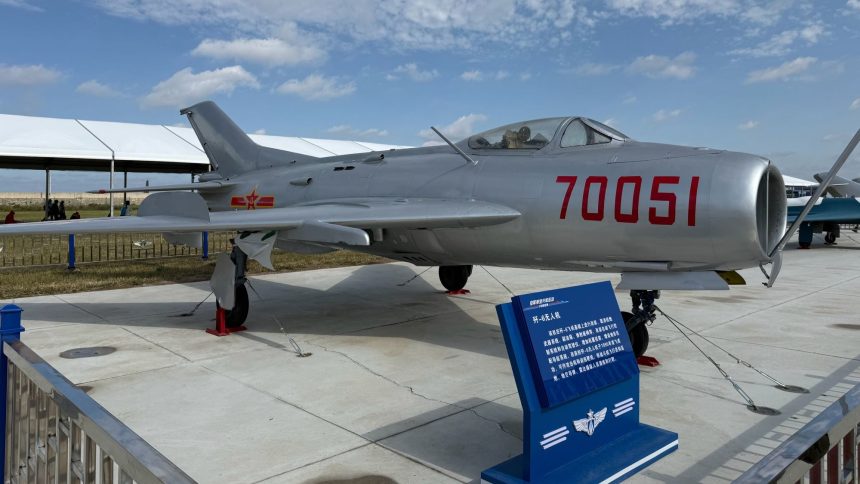Reports indicated the PLA Air Force is converting its older J-6, J-7 and J-8 jets into UAVs and UCAVs to be used from airfields in the Taiwan Strait.
In the run up to the Changchun Air Show in northeastern China this week, the first image of a legacy PLA Air Force Cold War-era J-6 jet converted into a UAV/UCAV has appeared. This confirms a long-held assessment and belief that the PLA would use the older J-6, J-7 and J-8 jets as attritable unmanned platforms for a variety of decoy and swarming roles – or both – in a Taiwan invasion.
Shared by leading Chinese military aviation researcher Andreas Rupprecht, one of the close-up shots show the pilot’s seat in the cockpit removed, indicated by a missing headrest, and a plaque in Mandarin identifying it as the J-6. Images of a J-6 meant for that role have appeared previously, with a picture from October 2021 shared by ‘East Pendulum’ showing two J-6s at an unidentified air base. The post said the “old J-6s, still in active service, but not quite like before,” hinting at their roles as UAVs/UCAVs.
The Shenyang J-6 and the Chengdu J-7 are Chinese versions of the Soviet MiG-19 and the MiG-21, respectively, initially license-built in the country. The PRC later heavily modified and customized the airframes with their own components and electronics. The J-8 meanwhile was a twin-engine heavy interceptor, developed as a clean-sheet design incorporating the lessons from the J-6 and J-7 programs.
For the first time a J-6W UCAV was put on display … here spotted at the Changchun Air Show.
Even more interesting however are reports, it has been retired already (indeed most likely) and the units that operated them now use GJ-11 or are to gain them soon.
(Via @军武次位面) pic.twitter.com/dWskXCYLyJ
— @Rupprecht_A (@RupprechtDeino) September 16, 2025
China’s ambitions to convert these legacy jets into UCAVs first emerged in the 2018 edition of the Zhuhai Air Show, when a display board demonstrated the PLA’s ambitions to modify the Q-5, J-6, J-7, and J-8, all otherwise under retirement, into UAVs. Then, on Jun. 17, 2021, according to The Diplomat the PLA dispatched four J-7 fighters into the southwest ADIZ of Taiwan. “Although they didn’t stay long in that area, it was the first time that J-7s had entered the area,” the report added.
Study about UCAV conversions
A November 2022 study by the Mitchell Institute of Aerospace Studies (MIAS), authored by non-resident fellow Daniel Rice, examined satellite images of five forward airfields from 2018 to 2022, and inferred their use to launch UAV and UCAV swarms against Taiwan.
Rice identifies the five airfields at Shuimen, Longtian, Luocheng/Huian, Zhangzhou, and Shantou. Shuimen, Longtian, Luocheng/Huian, and Zhangzhou airfields are located within the Chinese Fujian province, and Shantou is in the Guangdong province. Except for Shantou, that falls under the Southern Theatre Command, the rest of the four are under the Eastern Theater Command.
Tracking construction of facilities like hardened shelters, electrical supply and fuel and ammunition depots over time, the report concluded that these airfields “adjacent to the Taiwan Strait are intended for permanent, sustained operations in the event of a Chinese attack on Taiwan.” That report also identified the J-7s and J-6s hosted by these bases. Assuming they were converted as UCAVs, Rice concluded they could serve as the opening wave against Taiwanese CAPs (Combat Air Patrols) and air defenses.

The study also anticipates these legacy jets carrying air-to-air missiles, runway cratering bombs, unguided rockets, and anti-ship missiles. It remains to be seen if this is actually how the PLA would actually employ them, or use them at all. However, the emergence of the unmanned variant in an air show means that Chinese commanders have that option.
Theoretically, the massive drone swarms should significantly exhaust, if not completely deplete, Taiwanese anti-air stockpiles. China’s naval and air drills around Taiwan are now routine, regardless of the prevailing health of diplomatic relations.
Not only would any actual invasion be a mere extension of those rehearsals, but would be indistinguishable from the routine exercises. The PLA Navy and PLA Air Force would merely extend their naval and air blockades, until the U.S., allies and Taipei realize an invasion is underway.
As for the numbers and production of the UCAVs, the study identifies the PLAAF’s ‘Lushan J-6 Conversion Facility’, with a satellite image from Jun. 2018 showing two J-7s, and hundreds of J-6s parked there. The legacy fighter UCAV production appears to have “significantly ramped up in 2017,” and in 2020, a significant portion of the UCAVs were transferred off the airfield.

“As of December 2021, 235 legacy platforms can be identified at the conversion facility and on the Lushan ramp. As of April 2022, the total number of reported J-6W UCAVs may be 580 with 20 additional attack drones entering the (PLAAF Brigades) in November 2022,” Rice said in the MIAS report.
How would China use them
Drones are cheaper than manned planes, and they can unburden manned fighters of moderately complex yet routine logistical transport, CAP and surveillance tasks, while also being used in hurdles created by limitations of human endurance. Being manufactured within China since the 1960s also eases their modifications because of the involvement of their State Owned Enterprises.
We do not know if the J-6 in the image is programmed to release weapons, or if it is fully-, semi-autonomous or entirely remotely operated. Interestingly, a recent post by ‘SomePLAOSINT’ revealed that the PLAAF still uses a trainer variant of the J-7, called the JJ-7, with the last airframe delivered in 2017 – when the J-20 entered service. We have, however, not yet come across images of the unmanned versions of the J-7 or the J-8.
The MIAS study expects the drones to be the opening wave of attack preceding the frontline fighters. These include the J-16, its J-16D electronic warfare variant, Su-30MKK and JH-7 maritime strike aircraft, H-6K strategic bomber, J-35A, J-20, the J-10C and the PLA Navy’s navalized J-35, J-15A and J-15T.
The legacy aircraft-turned-drones are designated the J-6W, J-7W and J-8W, with anywhere between seven to ten hardpoints able to carry the older PL-2, PL-5, PL-7, PL-8, PL-9 and PL-12 AAMs and Kh-13 Anti-Ship Missiles.
Les vieux J-6, toujours en service actif, mais plus vraiment comme avant…#Drone #Kamikaze pic.twitter.com/QdEJRr7dA5
— East Pendulum (@HenriKenhmann) October 19, 2021
Calling it the Cicada strategy, the paper notes how “the PLAAF could choose to hide a large number of these UCAVs in underground shelters and have them surreptitiously emerge in mass for an attack on Taiwan.” The report strongly suggests targeting these airfields first, but notes that the U.S. military lacks long-range stand-off munitions that can penetrate the PLA’s Integrated Air Defense System (IADS).
“Although many combinations of platforms and munitions could suppress these airfields, the US Air Force currently lacks capacity in both delivery systems and munitions,” Rice said.
This is JJ-7. The trainer version of the J-7 family. The newest one was delivered to the PLAAF in 2017. This was after J-20 formally entered service. pic.twitter.com/JNnnImRkeY
— SomePLAOSINT (@someplaosint) September 16, 2025
The airfields
These airfields are generally guarded by HQ-9 and S-300 SAM systems. While Su-30MKKs and J-10s have been known to operate from Shuimen, Zhangzhou has J-7s and J-10s. Longtian and Shantou have the J-6 and J-7 unmanned combat aerial vehicles (UCAV), with the latter expected to operate the KJ-500 airborne early warning and control (AEW&C) aircraft.
China has also added the KJ-700, KJ-3000 AEW&C aircraft and the WZ-9 Divine Eagle unmanned airborne radars to its arsenal.

Based on the “imagery analysis, doctrinal research, and expert opinions,” Rice concluded that “the hardened shelters provide secure facilities for maintenance, refueling, and rearmament in the event of surge operations.”
“These airfields may also be instrumental in […] large-scale attack drone operations against Taiwan,” he added. “In the event of a PLA attack on Taiwan, it would be critical […] to suppress these airfields to blunt short-range fighter operations against Taiwan.”









